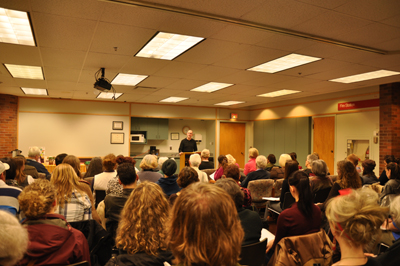Events
Best Foot Forward:
How to Enter the Literary Conversation
Summary of the Workshop that took place on November 23, 2011
By Melissa Hiebert

If you have ever thought about submitting writing to a literary journal for publication, The Malahat Review’s fall workshop “Best Foot Forward: How to Enter the Literary Conversation” was a thorough primer on how to enter the both tedious and rewarding world of publishing.
The talk was given by John Barton, who has been the editor of The Malahat Review for the past eight years. Barton, who is also a writer himself in addition to having worked in the literary magazine publishing industry for over 20 years, has been on both sides of the submission process. By his own admission, the seminar could have been subtitled, “how to come across well” or perhaps more forthright, “how not to annoy the editor.”
The talk included several different aspects of the submission process, right from finding the appropriate magazines to submit to, down to etiquette during the sometimes lengthy waiting period following submission.

To start the talk, Barton opened with a list of good reasons why one ought to publish in a literary magazine. “I think of them as testing grounds for new work,” said Barton. “It’s a place where you can try something out.” In addition to this, Barton explained that publishing in literary journals has the potential to raise general awareness about one’s work, as well as develop a readership, and participating in a community of writers in general. Also, Barton pointed out that just because a work is published in a literary journal, the work is not then set in stone: “[the work] will evolve. Either you’re going to change it, or someone you show it to will have comments, or you might…publish it in a book.”
One of the two most noteworthy websites mentioned for finding out about places to send writing were the Canadian-focused website placesforwriters.com, which features calls for submissions, contests, and a guide to literary magazines. The second was the American-based Duotrope.com, which boasts an impressive listing of 3800 publications. “When we’re all saying that we can’t get published, we are not trying hard enough,” quipped Barton, at the crowd’s reaction to the figure. 
Next came a discussion of strategy to keep in mind when submitting to different journals. Barton mentioned that it is typically improper etiquette to submit the same work to more than one journal at a time, though it is permissible to employ a “tiered submission” — that is, it is permissible to send a work to an esteemed journal where prospects are not quite as good, as well as a middle range or smaller publication. Typically, journal submissions take months to be read. If you have not heard back from a journal in nine months to a year, it is safe to resubmit to other publications.
Barton also provided a lengthy list of helpful tips to keep in mind when submitting to journals, which ranged from tips about what to put in a cover letter, to how to properly mail in submissions. For a complete list of the nitty-gritty aspects of submitting, the list can be found here.

In addition to regular submission, contests are also a good way to get your work out there. The submissions for contests are read separately from regular submissions, and are usually recognition-oriented (that is, they are a good idea to enter in order to get your work out there and generate interest in your writing). Contests are also considered to be “income generators” for publications with small budgets, as a submission fee is charged.
While submitting to literary magazines was the main focus of the talk, submitting to other types of publishers, such as book publishers and online magazines, was discussed. In this case, it is permissible to multiple submit. A good place to find out about publishers is lpg.ca, which has links to websites of small publishers. Barton also mentioned that a good publisher will do things for you, like send your book out for review.
The talk focused more on the submission process and less on suggestions about the actual task of writing itself. However, a few tips Barton gave about the works themselves is that they should avoid obvious sentiment, undue complexity, and should be polished.
Lastly, just because your submission was rejected, does not necessarily mean it is not up to snuff — it may just be that it is not what the journal is looking for at the time. For instance, Barton pointed out that if a journal has already published a few pieces on abortion that year already, they are unlikely to publish another submission on abortion, even if it is great. Timing is everything, and a submission that was rejected might be accepted at a different time. (Barton told a story of his own in which he accidentally sent his poems back to the same place after they had been rejected, and the second time they were accepted.) Also, if your work is rejected as is, but is sent back with constructive comments, it may not be a bad sign — “if you get a little bit of comment, it really means a lot,” says Barton. “[editors] don’t want to lead people on. . . I am only going to give you comments if I want to see [your work] again.”

Overall, the talk provided invaluable advice for those interested in “entering the literary conversation,” taking all of the confusion out of the submission process, and leaving one free to just worry about writing!









